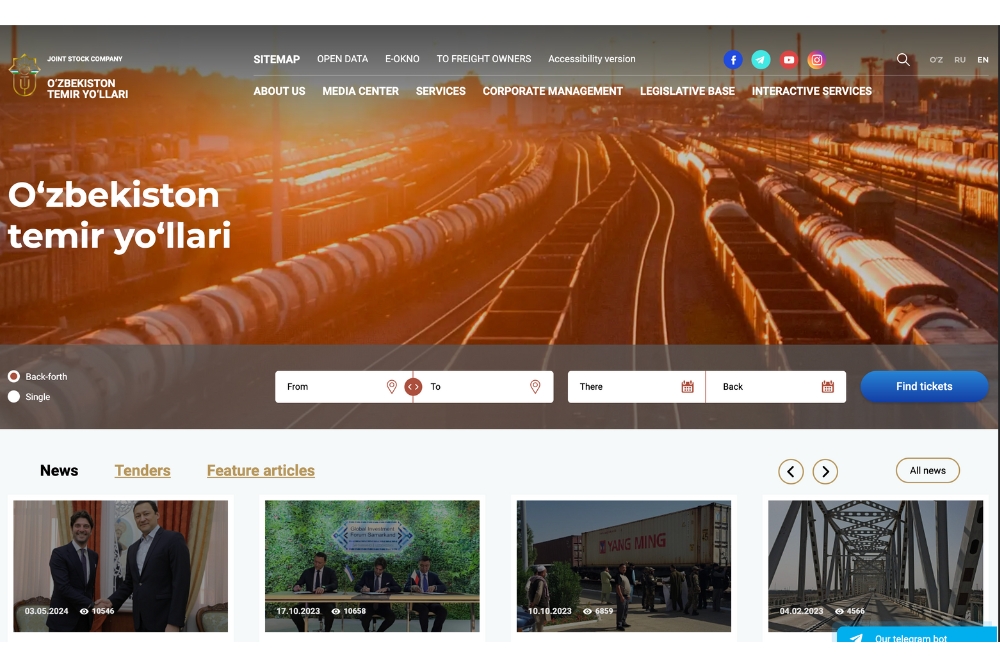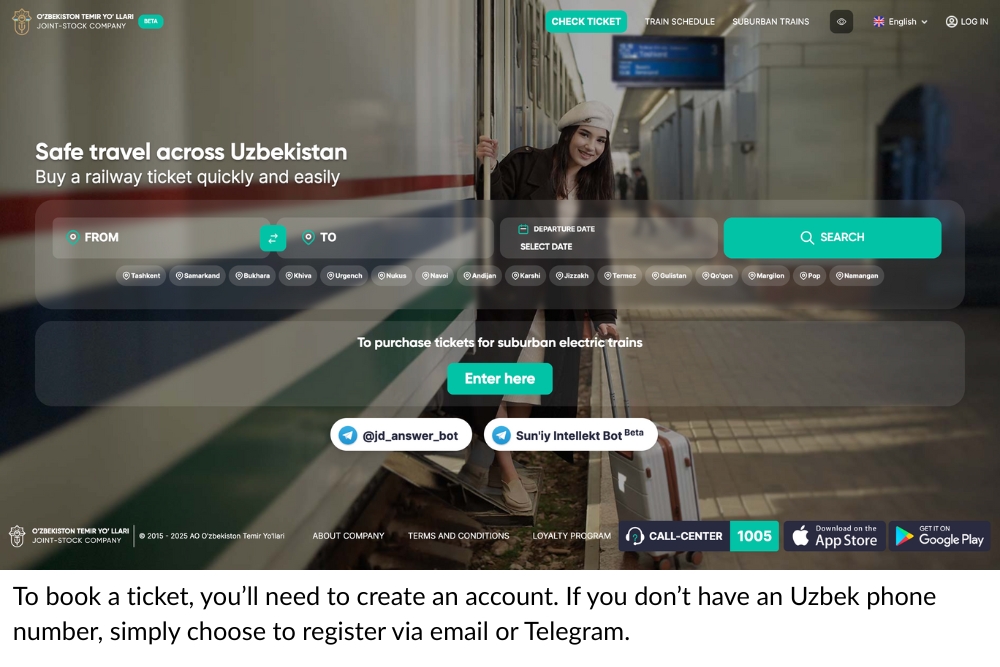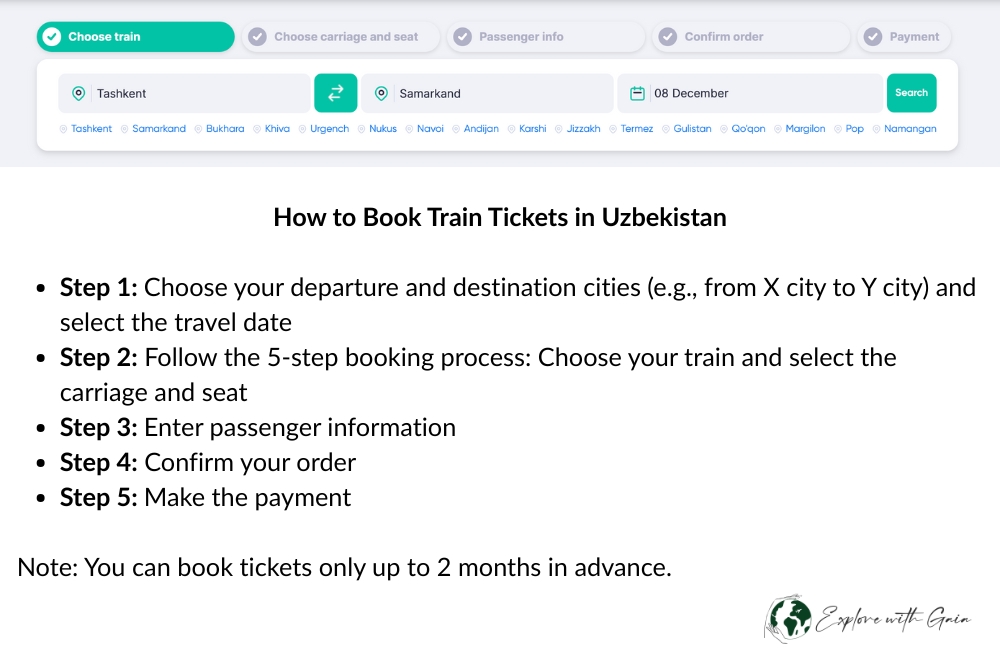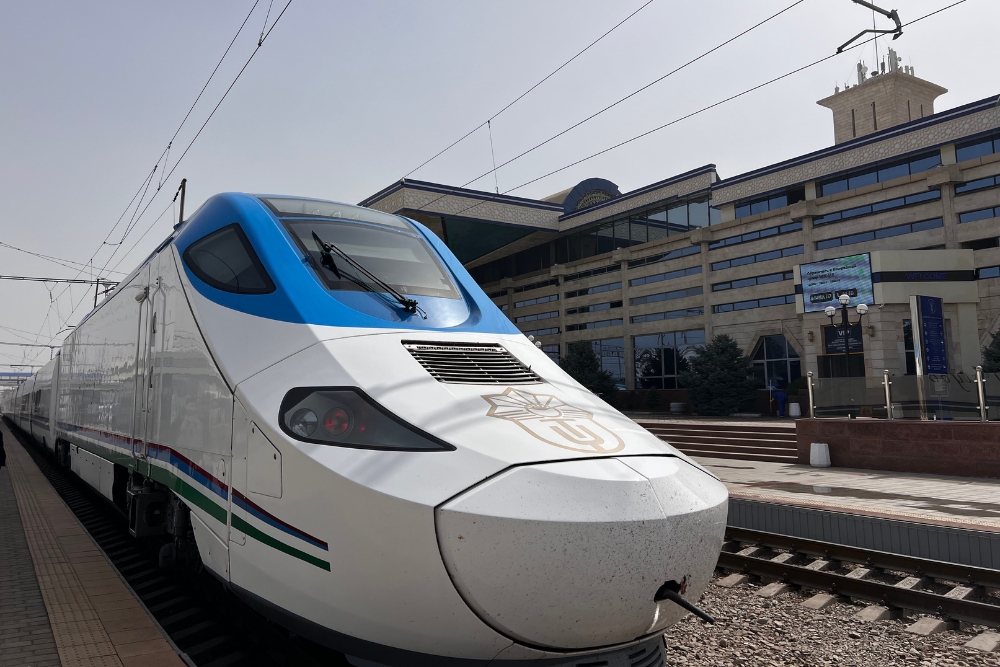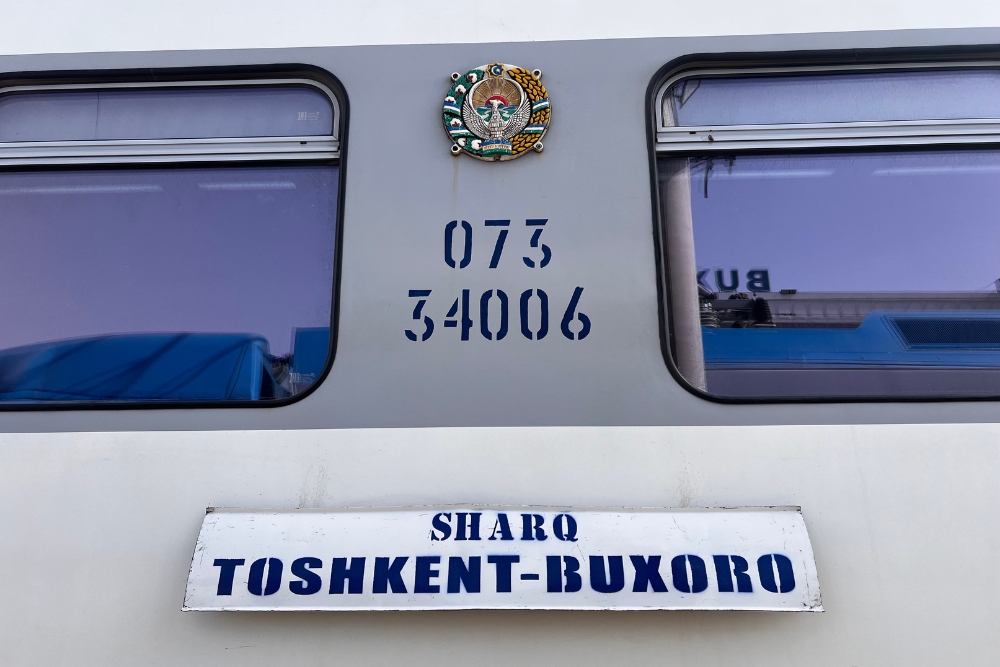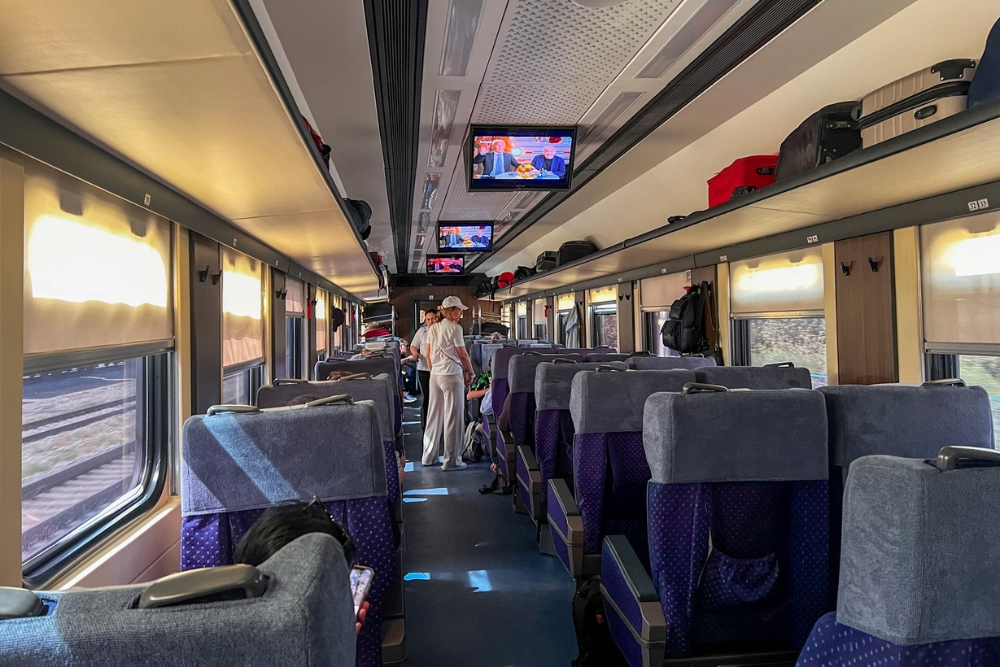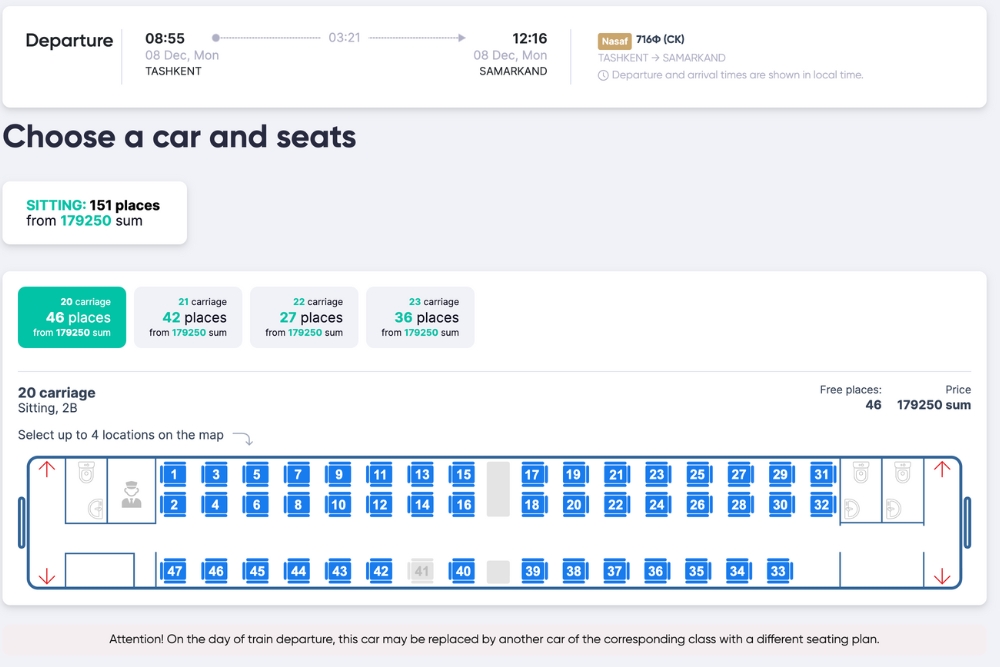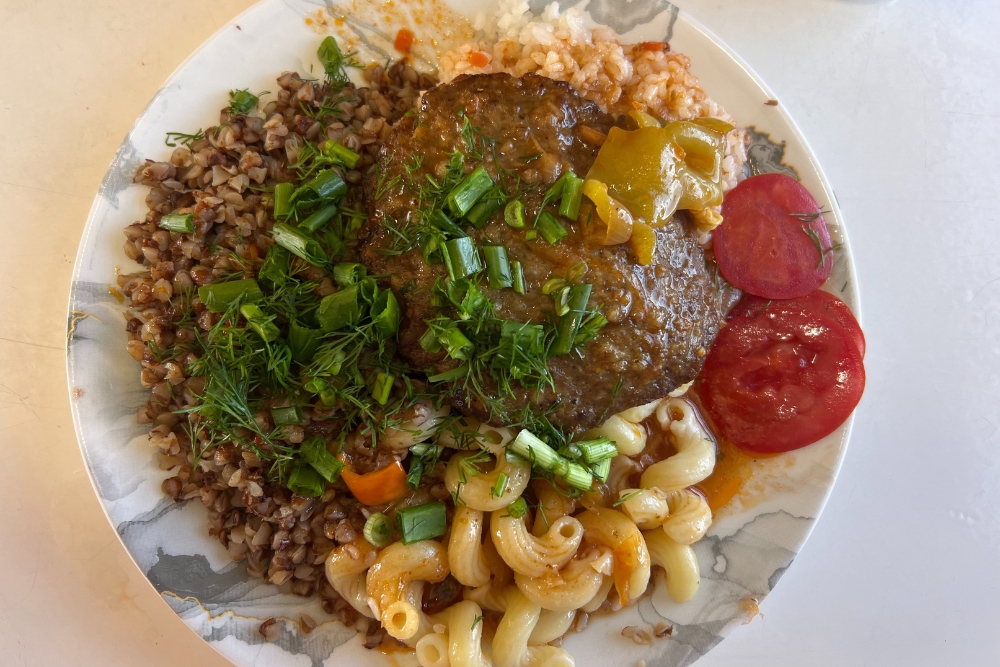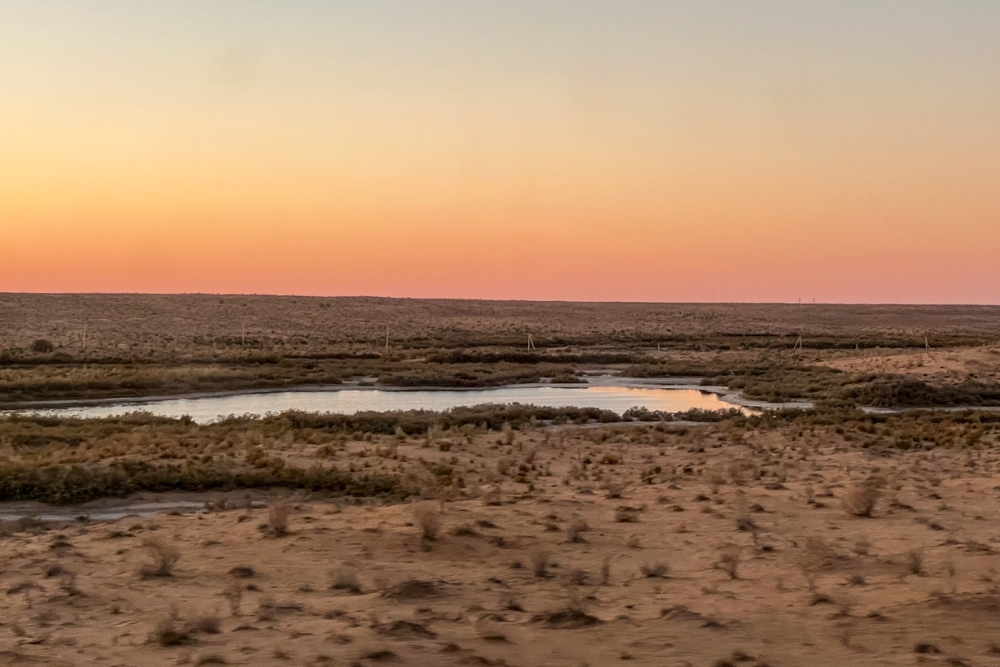Uzbekistan Train Travel Guide 2025: Routes, Booking Tips, and Real Costs
I thought booking a train ticket would be the easy part of traveling through Uzbekistan. I was wrong. Standing at Tashkent Railway Station on September 21st, 2025, watching a modern ticket machine reject my Visa card for the third time, I realized that traveling by train in Uzbekistan requires more than just showing up and buying a ticket. But here’s the thing: train travel in Uzbekistan turned out to be one of the best parts of my journey through Central Asia.
I spent two weeks traveling across Uzbekistan in September and October 2025, taking four different trains between the country’s major cities. From the high-speed Afrosiyob connecting Tashkent and Samarkand to a 16-hour overnight journey from Nukus back to the capital, I experienced the full spectrum of what Uzbekistan Railways has to offer. I made mistakes, learned workarounds, and discovered that the restaurant wagon is the best place to understand Uzbek hospitality.
If you’re a solo traveler or budget traveler planning to explore Uzbekistan independently, this guide will save you from the confusion I faced and help you navigate the surprisingly complex world of Uzbek train travel.
Is Train Travel in Uzbekistan Worth It for Budget Travelers?
Yes—with reservations.
Let me be completely honest with you. Train travel in Uzbekistan is worth it, but not because it’s always cheaper, faster, or more convenient than other options. It’s worth it because it’s the most authentic way to move between cities, meet locals and fellow travelers, and actually experience the country rather than just passing through it.
Understanding Uzbekistan Railways
Uzbekistan Railways, officially called O’zbekiston Temir Yo’llari, operates an extensive network connecting all major cities. The system is a fascinating mix of Soviet-era infrastructure and modern high-speed trains. The railway network branches from Tashkent, connecting to Samarkand, Bukhara, Urgench (for Khiva), and Nukus in the west.
My first impression of Tashkent’s station was the unexpected modernity of its parts. Electronic ticket machines with passport scanners, digital departure boards, and even QR codes on tickets. But that modernity exists alongside distinctly old-school elements.
- Those fancy machines only accept Uzbek bank cards. So I had to go to the kassa (ticket office), where I could pay in cash or by inserting my Visa card directly at the counter.
- The helpful staff at the ticket counters – They speak primarily Russian and Uzbek, with minimal English.
- The booking system – It has rules that make sense only when you understand the context, which I was about to learn the hard way.
When you open the website, first filter the language to the one you understand — whether it’s Russian, English, or Uzbek. Then, select the departure and arrival cities (you can choose any random ones just to test it). It will redirect you to another page — don’t worry, it’s the same official website, even though the design looks a bit different. There, you’ll be able to see the available trains, schedules, and other details.
Booking a ticket is easy; simply follow these five steps.
Tip: Booking Window Limitation
One important thing to know: Uzbekistan Railways only opens booking approximately 2 months in advance of the travel date. If you’re planning your trip several months in advance and the website shows no trains available or blank results, don’t panic—the tickets simply haven’t been released yet. You’ll need to wait until you’re within the 2-month window before availability appears in the system.
This applies to both online booking and station counters. I discovered this when trying to book tickets early in my planning phase, assuming popular routes were already sold out. However, the booking window simply hadn’t opened yet.
© Gayane Mkhitaryan, Nasaf (Regional Express Train), Uzbekistan
Types of Trains You’ll Actually Encounter
Depending on your destination, you’ll usually find five different types of trains operating in Uzbekistan.
For example, let’s take the Tashkent – Samarkand route as a reference.
Types of Trains in Uzbekistan (seats and prices)
Let’s break down each train type, what it offers, and the main differences between the seating classes — so you’ll know exactly what to expect before booking.
Afrosiyob (High-Speed Train)
© Gayane Mkhitaryan, Afrosiyob (High-Speed Train) in Samarkand Station
Afrosiyob is Uzbekistan’s flagship high-speed train service and the pride of the national railway system. These sleek, modern trains are Spanish-made Talgo 250 series that can reach speeds up to 250 km/h, making them the fastest way to travel between Uzbekistan’s major cities. The name “Afrosiyob” comes from a legendary Sogdian king, connecting this modern marvel to Central Asia’s ancient history.
Main Routes and Duration:
- Tashkent to Samarkand: 2 hours 13-25 minutes (various departure times throughout the day)
- Tashkent to Bukhara: Approximately 3 hours 40 minutes
- Samarkand to Bukhara: Around 1.5 hours
The Afrosiyob operates multiple daily services, with departures starting as early as 07:30 and running throughout the day. I took the morning service from Tashkent to Samarkand, and the speed and comfort were genuinely impressive—what used to take 5+ hours on older trains now takes just over two hours.
Onboard Features:
- Modern air conditioning that actually works (sometimes too well—bring a jacket)
- Clean, airline-style interiors with comfortable seating
- Restaurant wagon with hot meals, snacks, drinks, and tea
- Electrical outlets at seats (European plugs)
- Bathrooms at both ends of carriages (Western-style toilets)
- WiFi (theoretically available, practically non-functional)
- Large windows for viewing the landscape
- Smooth, quiet ride with minimal vibration
Seat Classes and Key Differences:
The Afrosiyob offers two main classes that differ significantly in price and comfort:
- Economy Class: This is what most travelers book, and it’s perfectly adequate for journeys under 3 hours. Seats are arranged in a 2-3 configuration—two seats on one side of the aisle, three on the other. The seats recline moderately and have fold-down tray tables, similar to those on airplanes. Legroom is decent for average-height passengers. The main drawback is the seating arrangement: some sections have seats facing each other in groups of six, which means you might spend your journey staring at strangers. This is exactly what happened to us, which is why we spent most of the time in the restaurant wagon.
- Business Class: Approximately 2x more expensive than economy, business class offers a 2-2 seating configuration with larger seats, more legroom, and better recline. You’re less likely to be stuck in facing-seat arrangements. Some services include complimentary refreshments. Business class also tends to be quieter with fewer families and groups.
Booking tip: The system only allows sequential seat bookings, so you can’t cherry-pick window seats on opposite sides of the aisle. You’ll get seats 35-36, not 35 and 42. This matters more in an economy where the 2-3 configuration means someone will be in a middle seat.
Sharq (Express Train)
Sharq trains are Uzbekistan’s mid-tier express service, bridging the gap between the ultra-modern Afrosiyob and the slower, older trains. These trains offer a good balance of speed, comfort, and affordability, making them popular with both locals and budget-conscious travelers. The name “Sharq” means “East” in Uzbek, reflecting the train’s role in connecting eastern and western parts of the country.
© Gayane Mkhitaryan, Samarkand Bukhara Train – Sharq (Express Train)
Main Routes and Duration:
- Tashkent to Samarkand: Approximately 3 hours 19-21 minutes
- Tashkent to Bukhara: Around 5-6 hours
- Various other intercity routes throughout the day and evening
Sharq trains operate on similar routes to the Afrosiyob but at slower speeds, typically running in the evening and night hours when Afrosiyob services are less frequent. From the screenshot, I can see a Sharq departure at 20:20 arriving at 23:39, which is ideal if you want to arrive in Samarkand in the evening rather than morning.
Onboard Features:
- Air conditioning (quality varies by specific train and carriage)
- Restaurant wagon on most services (smaller than Afrosiyob but functional)
- Reclining seats with adequate legroom
- Bathrooms at carriage ends (mix of Western and squat toilets)
- Some electrical outlets (less reliable than on Afrosiyob)
- Luggage racks overhead and at carriage ends
- Generally clean and well-maintained, though showing more age than Afrosiyob
© Gayane Mkhitaryan, Restaurant Wagon Sharq (Express Train)
Seat Class:
Sharq trains primarily offer one class, a sitting class with reclining seats. This is significantly cheaper than the Afrosiyob economy (about 34% less expensive), making it an attractive option if you’re on a tight budget and don’t mind the extra hour of travel time. The seats are comfortable enough for 3-4 hour journeys, arranged in a similar 2-3 or 2-2 configuration depending on the specific carriage. The ride is slightly less smooth than the Afrosiyob—you’ll feel the rails more—but it’s still comfortable. The main difference you’ll notice compared to high-speed trains is the pace: Sharq trains make more stops and take more time, but this can actually be interesting if you want to see smaller stations and towns along the route.
© Gayane Mkhitaryan, Samarkand Bukhara Train – Sharq (Express Train)
Nasaf (Regional Express Train)
Nasaf trains are another express service operating on Uzbekistan’s main routes, similar in concept to Sharq but often with slightly different schedules and routes. These trains serve as workhorses of the Uzbek railway system, reliably connecting cities throughout the day when the limited Afrosiyob services don’t align with travelers’ schedules.
© Gayane Mkhitaryan, Nasaf (Regional Express Train)
Main Routes and Duration
- Tashkent to Samarkand: Approximately 3 hours 21 minutes
- Connects to Qarshi and other southern destinations
- Multiple daily departures
As you can see from the screenshot, the Nasaf 716Ф departs Tashkent at 08:55 and arrives in Samarkand at 12:16, covering the route in a similar timeframe to Sharq trains. This mid-morning timing is particularly convenient if you want to sleep in a bit rather than catching the early Afrosiyob services.
© Gayane Mkhitaryan, Nasaf 716Ф (СК) Tashkent → Samarkand train seat map
Onboard Features
- Basic air conditioning (can be temperamental)
- Restaurant wagon or food cart service (varies by train)
- Reclining seats with reasonable comfort
- Bathrooms at carriage ends
- Overhead luggage storage
- Windows that open (though remember my dust warning—keep them closed!)
- Generally older rolling stock than Afrosiyob or Sharq
© Gayane Mkhitaryan, Restaurant Wagon Nasaf (Regional Express Train)
Seat Class
Nasaf trains offer sitting class at the same price point as Sharq services, making them interchangeable options for budget-conscious travelers. The main decision factor is departure time rather than any significant difference in comfort or amenities. Seats are arranged in various configurations depending on the specific carriage—some 2-2, some 2-3. Comfort is adequate for 3-4 hour journeys, though the seats might be slightly more worn than on newer Sharq trains. The ride quality is similar to Sharq—you’ll feel the movement more than on Afrosiyob, but it’s perfectly acceptable.
Ekspress/Express Trains (054Ф, 082Ф, 080…)
Express trains (often labeled “ekspress” or just with numbers like 054Ф) are the overnight and longer-distance services that form the backbone of Uzbekistan’s rail network. These are the trains you’ll take for journeys where you want to sleep en route, covering vast distances while you rest. This is the category that includes the train I took from Nukus to Tashkent—16 hours that passed comfortably in a sleeping compartment.
Main Routes and Duration
- Tashkent to Samarkand: 3-4 hours (daytime express services)
- Tashkent to Kungrad/Nukus: 16+ hours (overnight services)
- Tashkent South to Sariosiyo: 3-4 hours
- Tashkent South to Termez: Extended southern routes
- Various long-distance connections across the country
Express trains operate throughout the day and night, with overnight services typically departing in late afternoon or evening (around 13:15 for the Kungrad service, 20:54-20:55 for Sariosiyo services) to arrive at destinations the following morning. These are the trains that let you travel while sleeping, saving a night’s accommodation cost while covering distance.
© Gayane Mkhitaryan, скорый 054Щ (ск) Qongirot/Kungrad → Tashkent
Onboard Features
- Restaurant wagon (on longer routes, essential for 8+ hour journeys)
- Sleeping berths with provided bedding (sheets, pillow, blanket)
- Compartment doors that lock from the inside for security
- Bathrooms at both ends of each sleeping car (mix of Western and squat toilets)
- Basic heating/cooling (often too much or too little, hence the layering advice)
- Luggage storage under lower berths and above the door
- Conductors are present throughout the journey
- Tea service from conductors (usually available for purchase)
- Some electrical outlets in compartments (bring a power bank as a backup)
© Gayane Mkhitaryan, Lunch on a train
Seat/Berth Classes and Key Differences
Express trains offer multiple classes with significant differences in comfort, privacy, and price:
- Sleeper Class: This is a platskart—the open sleeping carriage with 54 berths and no privacy. Berths are arranged in groups along an open corridor. It’s the budget option, about 55% cheaper than the Kupe class. I never took platskart personally because kupe was affordable enough that privacy was worth it, but I saw these carriages and talked to travelers who used them. The consensus is that it’s fine for budget travelers who don’t mind communal sleeping arrangements and want to save money. Bring earplugs and an eye mask. Not ideal for women traveling solo who value privacy.
- Coupe/Kupe Class: This is the sweet spot for most travelers—4-berth compartments with a door that closes and locks. You get two lower berths and two upper berths, provided bedding, and crucially, privacy. This is what I typically book for overnight journeys. The compartments are cozy but not cramped, with enough space to store luggage under the lower berths and above the door. You can control your own lighting, have conversations without disturbing others, and actually sleep well. The key discovery I made is that booking all four berths costs 1,472,760 som total (4 × 368,190), essentially giving you a private cabin for not much more than what two people would pay for SV class. This is the strategy I used on the Nukus-Tashkent journey, and it made a 16-hour trip genuinely comfortable.
© Gayane Mkhitaryan, Coupe room скорый 054Щ (ск) train NUKUS → TASHKENT
© Gayane Mkhitaryan, Coupe room скорый 054Щ (ск) train NUKUS → TASHKENT
- SV/Spalny Vagon Class: The premium overnight option—2-berth compartments that are slightly more spacious than kupe. One upper berth, one lower berth, more storage space, sometimes somewhat better bedding.
© Gayane Mkhitaryan, SV room скорый 054Щ (ск) train NUKUS → TASHKENT
- General Class: This is a basic seating class on some overnight trains, even cheaper than platskart but without sleeping berths. You’d be sitting upright for the entire journey. Only consider this for shorter routes or if you’re extremely budget-constrained and can sleep sitting up. For overnight journeys over 8 hours, the small savings aren’t worth the discomfort.
Booking Strategy for Express Trains: For any overnight journey over 8 hours, I strongly recommend kupe or SV class. If you’re traveling as a couple or with a friend, consider the cost of booking all four kupe berths versus two SV berths—you might be surprised. The extra space and privacy of having your own compartment transform long journeys from endurance tests into actually enjoyable experiences. This is precisely what made my 16-hour Nukus-Tashkent journey one of the trip’s highlights, rather than just a means to survive.
The Volgograd Express
This deserves mention because it taught me an important lesson. It is a long-distance train service connecting Uzbekistan with Russia. Still, it also operates on domestic routes within Uzbekistan, including the Urgench to Nukus line that I attempted to take. This train is named after the Russian city of Volgograd (formerly Stalingrad) and represents the continued railway connections between former Soviet republics.
The Volgograd Express is notably different from other Uzbek domestic services. It’s an international train operating on domestic segments, which means it follows different operational standards and schedules. The carriages are older, the service is more basic, and critically, there are fewer alternative departures if problems occur. On popular routes like Tashkent-Samarkand, if one train is delayed, there are multiple others throughout the day. On the Urgench-Nukus route served by the Volgograd Express, you have only one or two options per day.
Onboard Features (When It Actually Runs)
Based on what I observed and heard from other travelers who’ve successfully taken this train:
- Basic sleeping compartments (kupe and platskart classes available)
- Restaurant wagon or food service (limited selection)
- Standard Soviet-era rolling stock (older carriages)
- Bathrooms at carriage ends
- Basic heating/cooling systems
- Luggage storage in compartments
The train itself isn’t particularly modern or comfortable compared to Afrosiyob or newer express trains. Still, for a 2-3 hour journey, comfort matters less than reliability, which turned out to be the real issue. We booked this train from Urgench to Nukus, and it was delayed by four hours. When I asked about compensation at the ticket counter, they offered a full refund or an alternative route. We took the refund—136,100 som per ticket—and found a shared taxi that cost 400,000 som but got us to Nukus without the stress.
How to Book Train Tickets: What Actually Works
Booking train tickets is more complicated than it should be, but it’s not impossible.
The Online Booking Reality
I successfully booked exactly one journey online—the Nukus to Tashkent overnight train. That’s it—one out of five. The system technically accepts international cards, but “technically” and “actually” are different things. My Visa card worked once, but was rejected multiple times for other routes. There’s no pattern to when international cards work.
If you do book online, tickets are issued as e-tickets with QR codes. The Nukus-Tashkent ticket worked perfectly—I showed my phone at the entrance and to the conductor. But you can’t rely on online booking. You need a backup plan.
The Passport-Per-Ticket Rule Nobody Tells You About
Uzbekistan Railways has a rule of one ticket per passport number. You cannot book two tickets under the same passport. When we tried to book all four beds in our compartment, the system wouldn’t accept a single passport for multiple tickets. We had to use different passport numbers—my passport, my boyfriend’s, and our mothers’ numbers. The conductors understood immediately. This rule exists to prevent ticket scalping, but it’s inconvenient for travelers wanting privacy.
The workaround is simple: if traveling with someone, use all available passport numbers. If you’re traveling solo but want a private compartment, you’ll need help from station staff or be willing to share.
Buying at Stations: My Strategy
After online complications, I developed a strategy: book your next journey as soon as you arrive in a new city. Popular routes sell out quickly. The Tashkent-Samarkand Afrosiyob often sells out 2-3 days in advance.
On September 21st in Tashkent, I first tried the electronic machines. They’re impressively high-tech with touchscreens and passport scanners. The process worked until payment, as machines only accept Uzbek bank cards.
At the ticket counter, bring your passport, have cash, know your route and date, and be ready to explain what class you want. The actual booking took about 10 minutes. Tickets are printed on thermal paper with all details clearly marked.
The Sequential Seat Problem: You cannot select random seats. The system only allows sequential bookings—seats 35 and 36, not 35 and 42. This means if you want window seats on opposite sides for views, it won’t work. During our Tashkent-Samarkand journey, we were paired with four strangers for two hours, which is why we ended up living in the restaurant wagon.
Booking Timeline Recommendations
- Afrosiyob trains: 2-3 days minimum
- Night trains: 2-4 days ahead
- Regular trains: 1-2 days usually fine
Third-Party Booking Options
Some hotels and hostels offer to book train tickets for you, usually for a small fee (around 20,000-50,000 som). This can be worth it if you’re struggling with the language barrier or don’t want to spend time at the station. However, you’re still subject to the same availability and pricing—they’re just navigating the system on your behalf.
I didn’t use this service because I wanted to understand the system myself, and I speak Russian. However, I met several travelers who found it helpful, especially in Samarkand and Bukhara, where some guesthouses offered this service.
Practical Tip: Arrive Early for Security Checkpoints
Plan to arrive at least 30-45 minutes before departure at major stations. Uzbek train stations have airport-style security that creates bottlenecks, especially in Tashkent and Samarkand during peak hours.
You’ll encounter security checks at multiple points. The first checkpoint happens before you even enter the station building. Security guards check your passport and ticket (or ask where you’re going if you’re buying tickets), and your luggage goes through an X-ray scanner. During busy times—morning departures and late afternoons—queues here can take 10-15 minutes or more.
After buying your ticket and before reaching the platform, there’s often a second security check with passport and ticket verification, sometimes another bag scan, depending on the station. The conductor checks your ticket and passport one more time as you board.
My recommended arrival times:
- Tashkent station needs 45-60 minutes (busiest station, longest queues),
- Samarkand station 40-45 minutes,
- Other major stations are 30-40 minutes.
- Smaller stations like Urgench or Nukus, 20-30 minutes is usually sufficient.
The time isn’t wasted—use it to grab snacks, fill water bottles, or simply relax in the waiting area rather than stressing about missing your train.
What to Expect on Uzbek Trains: The Reality
Let me set realistic expectations about what Uzbek trains are actually like, beyond the class descriptions and booking systems.
The Restaurant Wagon: Your Best Friend
I spent an embarrassing amount of time in restaurant wagons, but I regret nothing. The food quality surprised me—fresh, hot food prepared onboard. The lagman on Nukus-Tashkent was genuinely delicious with fresh vegetables, tender meat, and proper noodles.
Beyond food, it’s a social space. The woman running the Nukus-Tashkent restaurant was chatty, answering questions about Karakalpakstan. The cook came out to talk, and as other passengers arrived to eat, conversations flowed naturally. This is where we met travelers from across the world, all united by our Central Asian adventure.
On trains where seat assignments were problematic, the restaurant wagon gave us somewhere purposeful to go rather than standing in corridors.
© Gayane Mkhitaryan, Restaurant Wagon – Bukhara – Khiva (Пассажирский train)
Bathroom Reality
Let’s be honest: train bathrooms aren’t spotless. They’re functional at best, questionable at worst. Day trains have small but functional Western-style toilets. Overnight trains have bathrooms at both ends—typically one Western-style toilet and one squat toilet. The morning rush around 6-7 AM is real.
Survival tips: Go before morning rush, bring toilet paper and hand sanitizer, wear shoes you don’t mind getting wet.
The Dust Window Warning
DO NOT OPEN TRAIN WINDOWS. I learned this the hard way. On one journey, the compartment felt stuffy, so I opened the window. Within minutes, everything was covered in fine desert dust. Uzbekistan is largely desert, and trains kick up enormous dust. Opening a window invites it all in. Keep windows shut even on hot days.
© Gayane Mkhitaryan, Somewhere between Nukus and Tashkent
Dealing with Conductors
Most conductors are professional, but some see tourists as income opportunities. On the Nukus-Tashkent route, I asked the conductor to help fold down the upper berths (standard service). He said, “Money.” I speak Russian, so no misunderstanding. I said no, I didn’t need his help. He shrugged and left.
Conductors sometimes charge extra for services that should be included—folding berths, providing sheets, offering “upgrades.” Stand your ground politely but firmly. Don’t feel obligated to pay for basic services.
However, tips for genuinely helpful service are appreciated. If a conductor truly helps beyond their duty, 10,000-20,000 som is a nice gesture, though I never paid anything.
Meeting Fellow Travelers
One genuine joy was the traveler community. Unlike shared taxis, where you’re cramped and focused on arriving, trains give you space and time actually to meet people. On the Nukus-Tashkent train, we met travelers from Germany, France, the UK, China, and Korea in the restaurant wagon. Conversations were fascinating—comparing Central Asia experiences, sharing tips, and discovering connections.
To my surprise, several people had visited Armenia. There’s a consistent travel flow between Central Asia and the Caucasus.
Why Uzbekistan’s Trains Are Worth Every Complication
After 16 hours on the Nukus train, arriving at 6:18 AM in Tashkent, I realized train journeys had become as memorable as the destinations.
Yes, booking was complicated. Yes, there were frustrations. But these were minor compared to what I gained: genuine conversations with locals in restaurant wagons, unexpected friendships with travelers from across the world, time to read and process experiences, and views of a fascinating country passing by the window.
Train journeys revealed to me that Uzbekistan is more than just historic monuments. I saw the vast spaces between cities, the agricultural heartland, and smaller towns, landscapes shaping daily life. From overnight train windows, I saw sunrises over deserts, irrigation systems spanning miles, isolated settlements, and gradual transitions between regions you miss completely when flying.
Is train travel perfect? No. The booking process requires improvement, conductors need training, and payment systems must accept international cards.
Is it worth it? Absolutely, without question.
For solo and budget travelers exploring independently, trains offer the best combination of value, comfort, and authentic experience. They connect you not just to destinations but to the country itself and the community of travelers moving through it.
Embrace the complexity. Learn the system, navigate the stations, pack smart. The restaurant wagon conversations, overnight compartment privacy, sunrise views over Silk Road landscapes—these aren’t obstacles. They ARE the experience.
Uzbekistan’s trains are more than just transportation. They’re time machines that connect you to Silk Road history, social spaces that reveal contemporary life, and moving platforms for some of the best travel experiences you’ll have.



